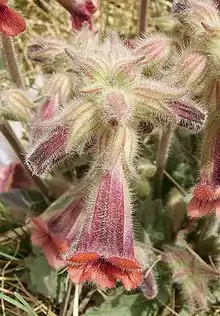Rehmannia glutinosa
Rehmannia glutinosa is a flowering broomrape, and one of the 50 fundamental herbs used in traditional Chinese medicine, where it has the name shēng dì huáng (Chinese: 生地黄). It is often sold as gān dì huáng (Chinese: 干地黄), gān meaning "dried". Unlike the majority of broomrapes, R. glutinosa is not parasitic, and is capable of independent photosynthesis.
| Rehmannia glutinosa | |
|---|---|
 | |
| Scientific classification | |
| Kingdom: | Plantae |
| Clade: | Tracheophytes |
| Clade: | Angiosperms |
| Clade: | Eudicots |
| Clade: | Asterids |
| Order: | Lamiales |
| Family: | Orobanchaceae |
| Genus: | Rehmannia |
| Species: | R. glutinosa |
| Binomial name | |
| Rehmannia glutinosa | |
Chemical constituents
A number of chemical constituents including iridoids, phenethyl alcohol, glycosides, cyclopentanoid monoterpenes, and norcarotenoids, have been reported from the fresh or processed roots of R. glutinosa.[2]
Etymology
- Rehmannia is named for Joseph Rehmann (1788–1831), a physician in St. Petersburg.[3][4]
- Glutinosa means 'glutinous', 'sticky', or 'viscous'.[3]
See also
- Chinese herbology – 50 fundamental herbs
References
- "Rehmannia glutinosa". Germplasm Resources Information Network. Agricultural Research Service, United States Department of Agriculture. Retrieved 2008-02-11.
- Oh, Hyuncheol (2006). "Remophilanetriol: A New Eremophilane from the Roots of Rehmannia glutinosa". ChemInform. 37 (2). doi:10.1002/chin.200602189.
- Gledhill, David (2008). "The Names of Plants". Cambridge University Press. ISBN 9780521866453 (hardback), ISBN 9780521685535 (paperback). pp 180, 328
- Joseph Rehmann. Sammlung auserlesener Abhandlungen und merkwürdiger Nachrichten Russischer Ärzte und Naturforscher. St. Petersburg 1812, p. 271-276: Ballota lanata. Ein neues Mittel gegen die Wassersucht. S. 271-276 (Digitalisat)
This article is issued from Wikipedia. The text is licensed under Creative Commons - Attribution - Sharealike. Additional terms may apply for the media files.